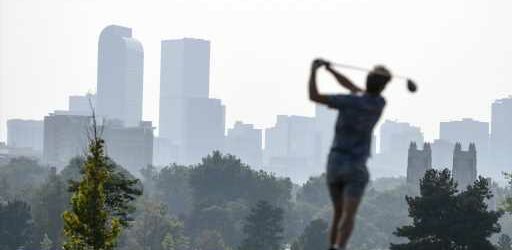An independent board tasked with improving Colorado’s air quality believes the state will fall short of meeting an Environmental Protection Agency requirement to lower toxic air pollution by 2024, but will be able to reach an older, more lax emissions-reduction target three years later.
Critics argue that Colorado’s plan to reach those goals falls short, continuing a pattern that led the EPA earlier this year to announce plans to downgrade the northern Front Range’s air quality rating.
And every time the state misses its goals to reduce air pollution, it jeopardizes the health of Colorado residents who live along the Front Range — and it becomes more expensive to fix because more regulations are placed on industries such as oil and gas, trucking and manufacturing.
“If we fail to act, it costs us time. It costs us additional requirements,” said Danny Katz, executive director of the Colorado Public Interest Research Group. “This is a really pivotal moment. We can’t wait another few years to act.”
The Regional Air Quality Council, an independent board appointed by the governor, is set to approve a plan for reducing harmful ground-level ozone emissions at an Aug. 5 meeting. The proposal, known as a State Implementation Plan, also must be approved by the state’s Air Quality Control Commission, which is expected to consider it in September, and the Environmental Protection Agency.
Regional Air Quality Council executive director Mike Silverstein said Tuesday during a media briefing that Colorado has two National Ambient Air Quality Standards to meet.
First, it needs to reach a standard adopted in 2008 requiring the reduction of ozone emissions to 75 parts per billion annually by 2027, and state air quality modeling indicates that will happen. Second, Colorado needs to reach a stricter standard set in 2015 of reducing ozone emissions even earlier, to 70 parts per billion by 2024.
“We aren’t expecting to reach that stringent standard within two short years,” Silverstein said. “It’s not possible to get us into compliance by the next due date.”
The goals seem out of line since the earlier deadline with a more stringent standard will be missed while the 2027 goal — with looser standards — is within reach. But Colorado has been failing to meet national air quality standards since 2012, so its target date for the 2008 standard keeps moving, said David Sabados, a spokesman for the air quality council.
Colorado needs to reduce its emissions of nitrogen oxides and volatile organic compounds because those substances combine on hot, sunny days to form a chemical reaction that creates ground-level ozone. That ozone causes smog that affects people’s respiratory systems, making it harder to breathe and complicating other pre-existing health conditions such as asthma.
And as the climate warms, it becomes harder to make improvements because the hotter it gets the more drastic the pollution becomes, said Gregg Thomas, the environmental quality division director for the Denver Department of Public Health and Environment.
Thomas, who participated in a media briefing with people who want the state’s implementation plan to go further, said he’s been working on ozone issues for 20 years and is frustrated by the series of missed goals that keep leading to EPA air quality downgrades.
“Each time we go through this iteration we’re hopeful that the next time it comes around — if it comes around again — we actually will have obtained the standard,” Thomas said. “It’s frustrating for us and for the public.”
In April, the EPA announced plans to downgrade Denver and the northern Front Range to “severe” violators of federal ozone standards from “serious” violators — a move that would trigger new regulations, including a requirement that Front Range motorists fill their cars and trucks with a more expensive reformulated gasoline.
The EPA is expected to make that designation official later this year.
If that happens, hundreds of businesses in the state also will be reclassified as major polluters, meaning they will need to apply for more complex federal emissions permits and spend more money to limit the pollutants they push into the atmosphere.
That’s why the Colorado Public Interest Research Group, the cities of Denver, Aurora, Boulder and Broomfield, and environmental groups are pushing the regional air council to go further. They recently sent a letter to the council with nine recommendations they want added to the state implementation plan.
Those recommendations include:
- Following California in adopting lower vehicle emissions standards
- Putting limits on oil and gas production during the hot summer months
- Creating more programs that encourage mass transit use
- Minimizing the use of flares at the Suncor Energy refinery in Commerce City
- Changing the rules for commercial and residential appliances so that nitrogen oxide emissions are reduced
For now, the regional air council’s plan does not include any drastic changes. The proposal does have contingency plans in play if the EPA says they are needed. Those plans include changes to regulations for architectural and industrial usage of adhesives, paints and coatings.
Thomas, who has served on the regional air council, said he understands the council’s position in trying to balance costs with the need to improve air quality, but he wants to see the council impose strategies that make significant reductions in ozone pollution.
“We may not see eye to eye sometimes on the urgency and the stringency of control measures. But we all want clean air,” he said. “We’re making progress in other areas of air pollution but ozone is a big bugaboo.”
The Regional Air Quality Council is accepting public comment on its State Implementation Plan through Wednesday at tinyurl.com/2p88v8h8. To learn more about the proposal visit tinyurl.com/2v2875em.
Source: Read Full Article


